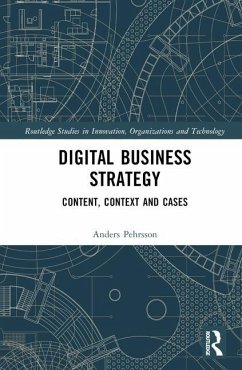- Gebundenes Buch
- Merkliste
- Auf die Merkliste
- Bewerten Bewerten
- Teilen
- Produkt teilen
- Produkterinnerung
- Produkterinnerung
Digital Business Strategy responds to the need for clarification of the increasing, but fragmented, knowledge of digital business strategy. It systematically presents topical knowledge by reviewing previous research and developing frameworks for the content of digital business strategy and its relationships with relevant factors. In addition, the book analyses issues encountered by individual companies when implementing digital business strategies.
The volume identifies key categories of digital business strategy, in particular, strategy scope and direction, competitive advantage, and…mehr
Andere Kunden interessierten sich auch für
![Public Innovation and Digital Transformation Public Innovation and Digital Transformation]() Public Innovation and Digital Transformation42,99 €
Public Innovation and Digital Transformation42,99 €![Managing IT for Innovation Managing IT for Innovation]() Mitsuru KodamaManaging IT for Innovation42,99 €
Mitsuru KodamaManaging IT for Innovation42,99 €![How is Digitalization Affecting Agri-food? How is Digitalization Affecting Agri-food?]() How is Digitalization Affecting Agri-food?44,99 €
How is Digitalization Affecting Agri-food?44,99 €![Sustainable International Business Models in a Digitally Transforming World Sustainable International Business Models in a Digitally Transforming World]() Sustainable International Business Models in a Digitally Transforming World45,99 €
Sustainable International Business Models in a Digitally Transforming World45,99 €![Strategic Foresight Strategic Foresight]() Jan Oliver SchwarzStrategic Foresight34,99 €
Jan Oliver SchwarzStrategic Foresight34,99 €![Sustainable International Business Models in a Digitally Transforming World Sustainable International Business Models in a Digitally Transforming World]() Sustainable International Business Models in a Digitally Transforming World142,99 €
Sustainable International Business Models in a Digitally Transforming World142,99 €![Machine Learning and Data Science in the Oil and Gas Industry Machine Learning and Data Science in the Oil and Gas Industry]() Machine Learning and Data Science in the Oil and Gas Industry108,99 €
Machine Learning and Data Science in the Oil and Gas Industry108,99 €-
-
-
Digital Business Strategy responds to the need for clarification of the increasing, but fragmented, knowledge of digital business strategy. It systematically presents topical knowledge by reviewing previous research and developing frameworks for the content of digital business strategy and its relationships with relevant factors. In addition, the book analyses issues encountered by individual companies when implementing digital business strategies.
The volume identifies key categories of digital business strategy, in particular, strategy scope and direction, competitive advantage, and resource and capability reliance. It then explores relationships with antecedents such as digital experience, relationships with obstacles and enablers of strategy implementation, and relationships with operational and financial outcomes. The author demonstrates that strategy content and relationships differ among manufacturing companies, retailers, digital content providers, and digital platforms and also presents ways to cope with issues of implementation.
In summary, the book provides readers who wish to know more about the growing field of digital business strategy with up-to-date and systematic knowledge. It will be of great value to students at an advanced level, researchers, and reflective practitioners in the fields of technology management and strategic management in particular.
The volume identifies key categories of digital business strategy, in particular, strategy scope and direction, competitive advantage, and resource and capability reliance. It then explores relationships with antecedents such as digital experience, relationships with obstacles and enablers of strategy implementation, and relationships with operational and financial outcomes. The author demonstrates that strategy content and relationships differ among manufacturing companies, retailers, digital content providers, and digital platforms and also presents ways to cope with issues of implementation.
In summary, the book provides readers who wish to know more about the growing field of digital business strategy with up-to-date and systematic knowledge. It will be of great value to students at an advanced level, researchers, and reflective practitioners in the fields of technology management and strategic management in particular.
Produktdetails
- Produktdetails
- Routledge Studies in Innovation, Organizations and Technology
- Verlag: Routledge / Taylor & Francis
- Seitenzahl: 170
- Erscheinungstermin: 20. Oktober 2023
- Englisch
- Abmessung: 240mm x 161mm x 14mm
- Gewicht: 398g
- ISBN-13: 9781032512471
- ISBN-10: 1032512474
- Artikelnr.: 68473072
- Herstellerkennzeichnung
- Libri GmbH
- Europaallee 1
- 36244 Bad Hersfeld
- gpsr@libri.de
- Routledge Studies in Innovation, Organizations and Technology
- Verlag: Routledge / Taylor & Francis
- Seitenzahl: 170
- Erscheinungstermin: 20. Oktober 2023
- Englisch
- Abmessung: 240mm x 161mm x 14mm
- Gewicht: 398g
- ISBN-13: 9781032512471
- ISBN-10: 1032512474
- Artikelnr.: 68473072
- Herstellerkennzeichnung
- Libri GmbH
- Europaallee 1
- 36244 Bad Hersfeld
- gpsr@libri.de
Anders Pehrsson is a Professor of Business Administration at the School of Business and Economics, Linnaeus University, Sweden. He received his PhD in industrial marketing from Linköping University in 1986. Dr. Pehrsson has written several books on company strategies. Routledge has previously published International Strategies in Telecommunications (1996), Strategy in Emerging Markets (2001), and Competitive International Strategy (2021). His articles have been published in journals such as Global Strategy Journal, International Marketing Review, Journal of Business Research, and Strategic Management Journal.
List of Figures
List of Tables
Preface
1 Content of This Volume
Why This Volume?
Specification of Digital Business Strategy
Previous Knowledge of Digital Business Strategy
Core Messages and Contributions
Message 1: Key Categories of Content of Digital Business Strategy
Message 2: Company Context Matters to Digital Business Strategy
Message 3: Company Cases Display Generic and Contextual Issues
References
PART I Content and Context of Digital Business Strategy
Introduction
2 The General Model for Digital Business Strategy
The Systematic Review of Studies on Digital Business Strategy
Conceptual Framework for the Review
Applied Methods
The Resulting General Model for Digital Business Strategy
Content of Digital Business Strategy
Strategy Scope or Direction
Competitive Advantage
Embedded Resources or Capabilities
Key Relationships
Antecedents of Digital Business Strategy
Implementation of Digital Business strategy
The Outcome of Digital Business Strategy
References
3 The Company Context and Digital Business Strategy
Chapter Abstract
The Meta-Analysis Reveals That Context Makes a Difference
Digital Business Strategies of Companies Not Specializing in Digitalization
Dominant Antecedents of Digital Business Strategy
Knowledge of Digital Transformation
Knowledge of Functional Digitalization
Competitive Dynamics
Digital Knowledge and Embedded Resources and Capabilities
Italian Manufacturing Companies and Other Companies
A South American Pensions and Savings Company
Competitive Dynamics and Embedded Resources and Capabilities
American Manufacturing Companies
A Singaporean Bank
Digital Business Strategies of Companies Specializing in Digitalization
The Outcome of Implementation of Competitive Advantage
Operational Outcome of the Implementation
Financial Outcome of the Implementation
Competitive Advantage and Operational Outcome
Low-Cost Digital Movie Production and Market Entry
Re-design of Mobile Apps and Customers' Product Adoption
Trust Affects Customers' Adoption of Digital Innovations
A South Korean Digital Platform Builds Customer Relationships
Competitive Advantage and Financial Outcome
Analysis of Big Data and Effects on Revenues for Digital Music
Unlicensed Usage of Digital Content and Revenue Loss
References
PART II Company Cases on Generic Issues
Introduction
4 Scope of Services and Customers of Digital Start-Ups
Specification of Scope of Digital Start-Ups
Relatedness and Synergy Between Service Units
A Narrow and a Broad Customer Scope
Case: Scope of a New Mobile Payment Platform
Characteristics and Challenges of Mobile Payment Platforms
Ways to Expand the Customer Base
Competition Among Mobile Payment Platforms
Questions to Discuss
References
5 Developing a Digital Competitive Advantage
Chapter Abstract
The Model for a Competitive International Strategy
The Scope of a Competitive International Strategy
Strategy Directions and Competitive Advantages
Focused and Global Standardization
Focused and Global Responsiveness
The Omnichannel Concept
Case: H&M Seeks a Digital Competitive Advantage in Retailing
The Traditional Business Strategy Relying on a Scale Advantage
The Adjusted Business Strategy Relying on Customer Experiences
Questions to Discuss
References
6 Acquisition of Dynamic Innovation Capabilities
What Makes Dynamic Capabilities Effective?
Application of the Dynamic Capability View
Market Knowledge Received From the Core Business
Market Knowledge Acquired Locally
The Dynamic Capabilities of Innovativeness and Responsiveness
Experience and Integration of Acquired Capabilities
The Importance of Experience to Acquisitions
Experience and the Initial Acquisition in a Host Country
Experience and Post-Initial Acquisitions in the Host Country
Integration of Acquired Capabilities
Case: Ericsson Acquires Dynamic Innovation Capabilities
Phase 1 (1998-2006): Integrating Fixed and Mobile Networks with the Internet
Phase 2 (2007-2016): Expanding the Scope of Digital Business
Phase 3 (2017-2021): Focusing the Digital Business Strategy
Questions to Discuss
References
PART III Company Cases on Contextually Based Issues
Introduction
7 Digital Business Strategy Issues of Manufacturing Companies
The Internet of Things, Big Data, and Digital Business Strategy
Case: the Digital Business Strategy of Volvo Cars
Competitive Dynamics and Customer Preferences
Digitalization of Volvo's Manufacturing and Supply Chains
Digital Resources and Capabilities in Volvo's Offering
Questions to Discuss
References
8 Business Strategy Issues of Digital Platforms
Profiles of Digital Platforms
Competitive Advantages of Digital Platforms
The Ecosystem of Google's Android Automotive OS
Case: Digital Booking in the Hotel Market
Marketing Innovativeness of Booking.com
Coopetition Among Digital Platforms and Hotels
Questions to Discuss
Case: Open Audio Platforms for Music and Blogs
Profiles of Open Audio Platforms
Questions to Discuss
References
PART IV Practical Strategy Development and Further Research
Introduction
9 How to Develop a Digital Business Strategy
Steps When Developing a Digital Business Strategy
Diagnosing Strategy Antecedents
Specifying the Content of the Strategy
What Strategy Scope, Direction, and Competitive Advantage?
What Embedded Resources and Capabilities?
Implementing the Strategy
Evaluating the Outcome of the Strategy Implementation
References
10 Suggestions for Further Research
Index
List of Tables
Preface
1 Content of This Volume
Why This Volume?
Specification of Digital Business Strategy
Previous Knowledge of Digital Business Strategy
Core Messages and Contributions
Message 1: Key Categories of Content of Digital Business Strategy
Message 2: Company Context Matters to Digital Business Strategy
Message 3: Company Cases Display Generic and Contextual Issues
References
PART I Content and Context of Digital Business Strategy
Introduction
2 The General Model for Digital Business Strategy
The Systematic Review of Studies on Digital Business Strategy
Conceptual Framework for the Review
Applied Methods
The Resulting General Model for Digital Business Strategy
Content of Digital Business Strategy
Strategy Scope or Direction
Competitive Advantage
Embedded Resources or Capabilities
Key Relationships
Antecedents of Digital Business Strategy
Implementation of Digital Business strategy
The Outcome of Digital Business Strategy
References
3 The Company Context and Digital Business Strategy
Chapter Abstract
The Meta-Analysis Reveals That Context Makes a Difference
Digital Business Strategies of Companies Not Specializing in Digitalization
Dominant Antecedents of Digital Business Strategy
Knowledge of Digital Transformation
Knowledge of Functional Digitalization
Competitive Dynamics
Digital Knowledge and Embedded Resources and Capabilities
Italian Manufacturing Companies and Other Companies
A South American Pensions and Savings Company
Competitive Dynamics and Embedded Resources and Capabilities
American Manufacturing Companies
A Singaporean Bank
Digital Business Strategies of Companies Specializing in Digitalization
The Outcome of Implementation of Competitive Advantage
Operational Outcome of the Implementation
Financial Outcome of the Implementation
Competitive Advantage and Operational Outcome
Low-Cost Digital Movie Production and Market Entry
Re-design of Mobile Apps and Customers' Product Adoption
Trust Affects Customers' Adoption of Digital Innovations
A South Korean Digital Platform Builds Customer Relationships
Competitive Advantage and Financial Outcome
Analysis of Big Data and Effects on Revenues for Digital Music
Unlicensed Usage of Digital Content and Revenue Loss
References
PART II Company Cases on Generic Issues
Introduction
4 Scope of Services and Customers of Digital Start-Ups
Specification of Scope of Digital Start-Ups
Relatedness and Synergy Between Service Units
A Narrow and a Broad Customer Scope
Case: Scope of a New Mobile Payment Platform
Characteristics and Challenges of Mobile Payment Platforms
Ways to Expand the Customer Base
Competition Among Mobile Payment Platforms
Questions to Discuss
References
5 Developing a Digital Competitive Advantage
Chapter Abstract
The Model for a Competitive International Strategy
The Scope of a Competitive International Strategy
Strategy Directions and Competitive Advantages
Focused and Global Standardization
Focused and Global Responsiveness
The Omnichannel Concept
Case: H&M Seeks a Digital Competitive Advantage in Retailing
The Traditional Business Strategy Relying on a Scale Advantage
The Adjusted Business Strategy Relying on Customer Experiences
Questions to Discuss
References
6 Acquisition of Dynamic Innovation Capabilities
What Makes Dynamic Capabilities Effective?
Application of the Dynamic Capability View
Market Knowledge Received From the Core Business
Market Knowledge Acquired Locally
The Dynamic Capabilities of Innovativeness and Responsiveness
Experience and Integration of Acquired Capabilities
The Importance of Experience to Acquisitions
Experience and the Initial Acquisition in a Host Country
Experience and Post-Initial Acquisitions in the Host Country
Integration of Acquired Capabilities
Case: Ericsson Acquires Dynamic Innovation Capabilities
Phase 1 (1998-2006): Integrating Fixed and Mobile Networks with the Internet
Phase 2 (2007-2016): Expanding the Scope of Digital Business
Phase 3 (2017-2021): Focusing the Digital Business Strategy
Questions to Discuss
References
PART III Company Cases on Contextually Based Issues
Introduction
7 Digital Business Strategy Issues of Manufacturing Companies
The Internet of Things, Big Data, and Digital Business Strategy
Case: the Digital Business Strategy of Volvo Cars
Competitive Dynamics and Customer Preferences
Digitalization of Volvo's Manufacturing and Supply Chains
Digital Resources and Capabilities in Volvo's Offering
Questions to Discuss
References
8 Business Strategy Issues of Digital Platforms
Profiles of Digital Platforms
Competitive Advantages of Digital Platforms
The Ecosystem of Google's Android Automotive OS
Case: Digital Booking in the Hotel Market
Marketing Innovativeness of Booking.com
Coopetition Among Digital Platforms and Hotels
Questions to Discuss
Case: Open Audio Platforms for Music and Blogs
Profiles of Open Audio Platforms
Questions to Discuss
References
PART IV Practical Strategy Development and Further Research
Introduction
9 How to Develop a Digital Business Strategy
Steps When Developing a Digital Business Strategy
Diagnosing Strategy Antecedents
Specifying the Content of the Strategy
What Strategy Scope, Direction, and Competitive Advantage?
What Embedded Resources and Capabilities?
Implementing the Strategy
Evaluating the Outcome of the Strategy Implementation
References
10 Suggestions for Further Research
Index
List of Figures
List of Tables
Preface
1 Content of This Volume
Why This Volume?
Specification of Digital Business Strategy
Previous Knowledge of Digital Business Strategy
Core Messages and Contributions
Message 1: Key Categories of Content of Digital Business Strategy
Message 2: Company Context Matters to Digital Business Strategy
Message 3: Company Cases Display Generic and Contextual Issues
References
PART I Content and Context of Digital Business Strategy
Introduction
2 The General Model for Digital Business Strategy
The Systematic Review of Studies on Digital Business Strategy
Conceptual Framework for the Review
Applied Methods
The Resulting General Model for Digital Business Strategy
Content of Digital Business Strategy
Strategy Scope or Direction
Competitive Advantage
Embedded Resources or Capabilities
Key Relationships
Antecedents of Digital Business Strategy
Implementation of Digital Business strategy
The Outcome of Digital Business Strategy
References
3 The Company Context and Digital Business Strategy
Chapter Abstract
The Meta-Analysis Reveals That Context Makes a Difference
Digital Business Strategies of Companies Not Specializing in Digitalization
Dominant Antecedents of Digital Business Strategy
Knowledge of Digital Transformation
Knowledge of Functional Digitalization
Competitive Dynamics
Digital Knowledge and Embedded Resources and Capabilities
Italian Manufacturing Companies and Other Companies
A South American Pensions and Savings Company
Competitive Dynamics and Embedded Resources and Capabilities
American Manufacturing Companies
A Singaporean Bank
Digital Business Strategies of Companies Specializing in Digitalization
The Outcome of Implementation of Competitive Advantage
Operational Outcome of the Implementation
Financial Outcome of the Implementation
Competitive Advantage and Operational Outcome
Low-Cost Digital Movie Production and Market Entry
Re-design of Mobile Apps and Customers' Product Adoption
Trust Affects Customers' Adoption of Digital Innovations
A South Korean Digital Platform Builds Customer Relationships
Competitive Advantage and Financial Outcome
Analysis of Big Data and Effects on Revenues for Digital Music
Unlicensed Usage of Digital Content and Revenue Loss
References
PART II Company Cases on Generic Issues
Introduction
4 Scope of Services and Customers of Digital Start-Ups
Specification of Scope of Digital Start-Ups
Relatedness and Synergy Between Service Units
A Narrow and a Broad Customer Scope
Case: Scope of a New Mobile Payment Platform
Characteristics and Challenges of Mobile Payment Platforms
Ways to Expand the Customer Base
Competition Among Mobile Payment Platforms
Questions to Discuss
References
5 Developing a Digital Competitive Advantage
Chapter Abstract
The Model for a Competitive International Strategy
The Scope of a Competitive International Strategy
Strategy Directions and Competitive Advantages
Focused and Global Standardization
Focused and Global Responsiveness
The Omnichannel Concept
Case: H&M Seeks a Digital Competitive Advantage in Retailing
The Traditional Business Strategy Relying on a Scale Advantage
The Adjusted Business Strategy Relying on Customer Experiences
Questions to Discuss
References
6 Acquisition of Dynamic Innovation Capabilities
What Makes Dynamic Capabilities Effective?
Application of the Dynamic Capability View
Market Knowledge Received From the Core Business
Market Knowledge Acquired Locally
The Dynamic Capabilities of Innovativeness and Responsiveness
Experience and Integration of Acquired Capabilities
The Importance of Experience to Acquisitions
Experience and the Initial Acquisition in a Host Country
Experience and Post-Initial Acquisitions in the Host Country
Integration of Acquired Capabilities
Case: Ericsson Acquires Dynamic Innovation Capabilities
Phase 1 (1998-2006): Integrating Fixed and Mobile Networks with the Internet
Phase 2 (2007-2016): Expanding the Scope of Digital Business
Phase 3 (2017-2021): Focusing the Digital Business Strategy
Questions to Discuss
References
PART III Company Cases on Contextually Based Issues
Introduction
7 Digital Business Strategy Issues of Manufacturing Companies
The Internet of Things, Big Data, and Digital Business Strategy
Case: the Digital Business Strategy of Volvo Cars
Competitive Dynamics and Customer Preferences
Digitalization of Volvo's Manufacturing and Supply Chains
Digital Resources and Capabilities in Volvo's Offering
Questions to Discuss
References
8 Business Strategy Issues of Digital Platforms
Profiles of Digital Platforms
Competitive Advantages of Digital Platforms
The Ecosystem of Google's Android Automotive OS
Case: Digital Booking in the Hotel Market
Marketing Innovativeness of Booking.com
Coopetition Among Digital Platforms and Hotels
Questions to Discuss
Case: Open Audio Platforms for Music and Blogs
Profiles of Open Audio Platforms
Questions to Discuss
References
PART IV Practical Strategy Development and Further Research
Introduction
9 How to Develop a Digital Business Strategy
Steps When Developing a Digital Business Strategy
Diagnosing Strategy Antecedents
Specifying the Content of the Strategy
What Strategy Scope, Direction, and Competitive Advantage?
What Embedded Resources and Capabilities?
Implementing the Strategy
Evaluating the Outcome of the Strategy Implementation
References
10 Suggestions for Further Research
Index
List of Tables
Preface
1 Content of This Volume
Why This Volume?
Specification of Digital Business Strategy
Previous Knowledge of Digital Business Strategy
Core Messages and Contributions
Message 1: Key Categories of Content of Digital Business Strategy
Message 2: Company Context Matters to Digital Business Strategy
Message 3: Company Cases Display Generic and Contextual Issues
References
PART I Content and Context of Digital Business Strategy
Introduction
2 The General Model for Digital Business Strategy
The Systematic Review of Studies on Digital Business Strategy
Conceptual Framework for the Review
Applied Methods
The Resulting General Model for Digital Business Strategy
Content of Digital Business Strategy
Strategy Scope or Direction
Competitive Advantage
Embedded Resources or Capabilities
Key Relationships
Antecedents of Digital Business Strategy
Implementation of Digital Business strategy
The Outcome of Digital Business Strategy
References
3 The Company Context and Digital Business Strategy
Chapter Abstract
The Meta-Analysis Reveals That Context Makes a Difference
Digital Business Strategies of Companies Not Specializing in Digitalization
Dominant Antecedents of Digital Business Strategy
Knowledge of Digital Transformation
Knowledge of Functional Digitalization
Competitive Dynamics
Digital Knowledge and Embedded Resources and Capabilities
Italian Manufacturing Companies and Other Companies
A South American Pensions and Savings Company
Competitive Dynamics and Embedded Resources and Capabilities
American Manufacturing Companies
A Singaporean Bank
Digital Business Strategies of Companies Specializing in Digitalization
The Outcome of Implementation of Competitive Advantage
Operational Outcome of the Implementation
Financial Outcome of the Implementation
Competitive Advantage and Operational Outcome
Low-Cost Digital Movie Production and Market Entry
Re-design of Mobile Apps and Customers' Product Adoption
Trust Affects Customers' Adoption of Digital Innovations
A South Korean Digital Platform Builds Customer Relationships
Competitive Advantage and Financial Outcome
Analysis of Big Data and Effects on Revenues for Digital Music
Unlicensed Usage of Digital Content and Revenue Loss
References
PART II Company Cases on Generic Issues
Introduction
4 Scope of Services and Customers of Digital Start-Ups
Specification of Scope of Digital Start-Ups
Relatedness and Synergy Between Service Units
A Narrow and a Broad Customer Scope
Case: Scope of a New Mobile Payment Platform
Characteristics and Challenges of Mobile Payment Platforms
Ways to Expand the Customer Base
Competition Among Mobile Payment Platforms
Questions to Discuss
References
5 Developing a Digital Competitive Advantage
Chapter Abstract
The Model for a Competitive International Strategy
The Scope of a Competitive International Strategy
Strategy Directions and Competitive Advantages
Focused and Global Standardization
Focused and Global Responsiveness
The Omnichannel Concept
Case: H&M Seeks a Digital Competitive Advantage in Retailing
The Traditional Business Strategy Relying on a Scale Advantage
The Adjusted Business Strategy Relying on Customer Experiences
Questions to Discuss
References
6 Acquisition of Dynamic Innovation Capabilities
What Makes Dynamic Capabilities Effective?
Application of the Dynamic Capability View
Market Knowledge Received From the Core Business
Market Knowledge Acquired Locally
The Dynamic Capabilities of Innovativeness and Responsiveness
Experience and Integration of Acquired Capabilities
The Importance of Experience to Acquisitions
Experience and the Initial Acquisition in a Host Country
Experience and Post-Initial Acquisitions in the Host Country
Integration of Acquired Capabilities
Case: Ericsson Acquires Dynamic Innovation Capabilities
Phase 1 (1998-2006): Integrating Fixed and Mobile Networks with the Internet
Phase 2 (2007-2016): Expanding the Scope of Digital Business
Phase 3 (2017-2021): Focusing the Digital Business Strategy
Questions to Discuss
References
PART III Company Cases on Contextually Based Issues
Introduction
7 Digital Business Strategy Issues of Manufacturing Companies
The Internet of Things, Big Data, and Digital Business Strategy
Case: the Digital Business Strategy of Volvo Cars
Competitive Dynamics and Customer Preferences
Digitalization of Volvo's Manufacturing and Supply Chains
Digital Resources and Capabilities in Volvo's Offering
Questions to Discuss
References
8 Business Strategy Issues of Digital Platforms
Profiles of Digital Platforms
Competitive Advantages of Digital Platforms
The Ecosystem of Google's Android Automotive OS
Case: Digital Booking in the Hotel Market
Marketing Innovativeness of Booking.com
Coopetition Among Digital Platforms and Hotels
Questions to Discuss
Case: Open Audio Platforms for Music and Blogs
Profiles of Open Audio Platforms
Questions to Discuss
References
PART IV Practical Strategy Development and Further Research
Introduction
9 How to Develop a Digital Business Strategy
Steps When Developing a Digital Business Strategy
Diagnosing Strategy Antecedents
Specifying the Content of the Strategy
What Strategy Scope, Direction, and Competitive Advantage?
What Embedded Resources and Capabilities?
Implementing the Strategy
Evaluating the Outcome of the Strategy Implementation
References
10 Suggestions for Further Research
Index









